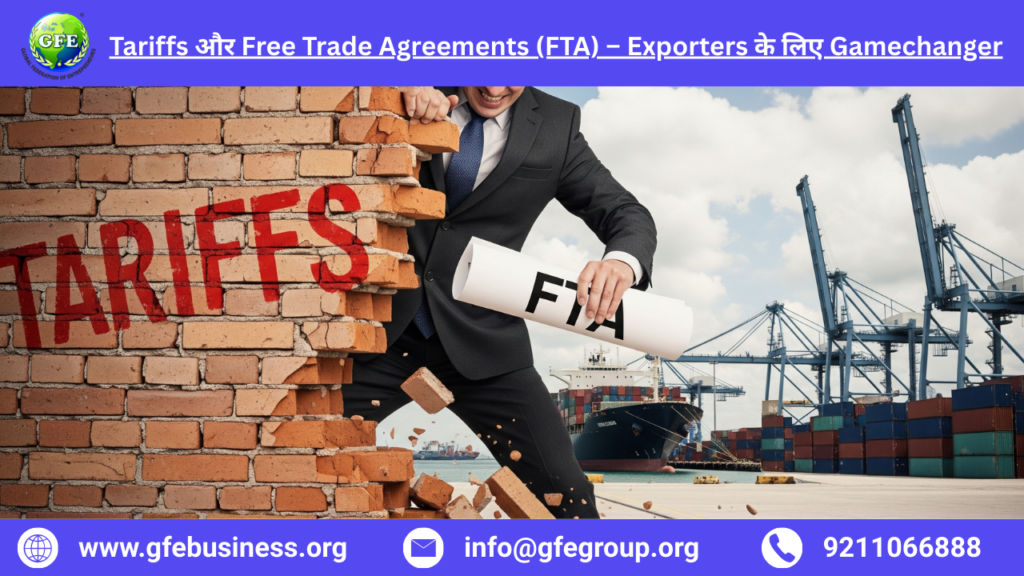Global trade is constantly evolving, and two of the most powerful forces shaping the business landscape today are tariffs and free trade agreements (FTAs). For Indian exporters, understanding how these factors impact international trade is not optional—it is essential for growth and competitiveness.
In fact, platforms like GFE Business have been guiding exporters and entrepreneurs on how to navigate tariffs, leverage FTAs, and use government incentives to maximize profits in global markets. Without proper knowledge, exporters risk losing money due to unexpected duties, compliance issues, or missed opportunities in tariff-free zones.
In this guide, we’ll explore:
What tariffs are and why they matter.
How free trade agreements reshape global markets.
The key FTAs that India is part of and what benefits they offer.
Practical strategies to reduce tariff burdens and expand exports.
Case studies of how exporters have successfully used FTAs as a gamechanger.
What are Tariffs?
Tariffs are taxes imposed on goods when they move across international borders. For exporters, tariffs directly affect the price competitiveness of products in foreign markets.
Types of Tariffs
Ad Valorem Tariff – A percentage of the product’s value (e.g., 10% of invoice price).
Specific Tariff – A fixed fee per unit, weight, or quantity (e.g., $5 per kg).
Mixed Tariff – A combination of both ad valorem and specific tariffs.
Tariff-Rate Quotas (TRQs) – Reduced tariff up to a certain quantity, then higher tariffs beyond.
Why Tariffs Exist
Protect domestic industries from cheaper imports.
Generate revenue for governments.
Balance trade deficits by reducing imports.
Retaliatory measure in trade wars (like the U.S.–China trade war).
For Indian exporters, tariffs can either act as a barrier (making products costlier abroad) or an opportunity (if India gets preferential treatment under an FTA).
What are Free Trade Agreements (FTAs)?
Free Trade Agreements are treaties between countries to reduce or eliminate tariffs and other trade barriers.
Benefits of FTAs for Exporters
Lower or Zero Tariffs – Makes Indian products more competitive.
Market Access – Entry into regions with high demand (like UAE, EU, ASEAN).
Diversification – Reduced dependence on a single market.
Supply Chain Integration – Participation in global value chains.
India’s Active FTAs
India has signed several FTAs that exporters must be aware of:
India–UAE CEPA (Comprehensive Economic Partnership Agreement) – Over 90% of Indian exports now enjoy zero duty in UAE.
India–Australia ECTA (Economic Cooperation and Trade Agreement) – Covers textiles, gems, engineering goods, pharma.
India–ASEAN FTA – Duty reduction across Southeast Asia.
India–Japan CEPA – Strong demand for machinery, auto parts, and processed foods.
Upcoming FTAs – Talks ongoing with UK, EU, and Canada.
For exporters, each FTA opens up specific opportunities, but they need to understand HS Codes, Rules of Origin, and Certificate of Origin (COO) requirements to actually benefit.
Tariffs vs FTAs: The Gamechanger Effect
Imagine two exporters:
Exporter A sells textile garments to the UAE without using the CEPA agreement → Pays 5–10% duty.
Exporter B uses CEPA benefits → Pays zero duty and offers lower prices to buyers.
Guess who wins the deal?
This is why awareness of FTAs and tariffs is not just paperwork—it’s a competitive edge.
Case Study 1: Indian Pharma in Brazil and Russia
Brazil and Russia impose hefty tariffs on Chinese pharma imports but offer lower duties for Indian medicines under bilateral arrangements. This has allowed India’s pharma exports to grow rapidly in these markets, especially post-pandemic.
Case Study 2: Textiles in Australia
Before the India–Australia ECTA, Indian textile exports faced 5% duty. Post-FTA, duties were eliminated, giving Indian exporters a pricing advantage over Chinese suppliers. Within a year, exports rose by double digits.
Key Challenges for Exporters
Complex Documentation – COO, HS Codes, and compliance rules vary by agreement.
Awareness Gap – Many small exporters are unaware of FTA benefits.
Competition – Countries like Vietnam and Bangladesh are also leveraging FTAs.
Non-Tariff Barriers (NTBs) – Even with zero tariffs, quality standards and certifications can delay entry.
Practical Strategies to Maximize FTA Benefits
1. Identify HS Codes and Tariff Rates
Every product is classified under an HS Code (Harmonized System). Exporters should use global tariff finder tools (like WTO Tariff Database or country-specific portals) to check exact duties.
2. Claim Certificate of Origin (COO)
To enjoy tariff benefits under an FTA, exporters must provide proof that goods were manufactured in India. This is done through a COO issued by DGFT or export councils.
3. Negotiate with Buyers Using FTA Data
Highlight tariff savings in negotiations. Example: “Our products get zero duty under India–UAE CEPA, giving you 5% cost savings compared to Chinese suppliers.”
4. Leverage Government Support
Schemes like RoDTEP, EPCG, and PLI further reduce costs for exporters.
5. Stay Updated
Tariff rates and FTA rules change frequently. Exporters should stay connected with trade bodies or platforms like GFE Business for latest updates.
Future Outlook: 2025–2030
More FTAs – India is negotiating deals with EU, UK, Canada, and Gulf countries. These will open high-value markets for textiles, gems, and engineering goods.
Shift from China – Ongoing U.S.–China tensions mean India will be a preferred sourcing hub for many global buyers.
Digital FTAs – Future agreements may also cover digital trade, e-commerce, and data sharing.
Focus on Sustainability – FTAs will include stricter environmental and labor standards; exporters must adapt.
Final Thoughts
Tariffs and FTAs are not just trade policies—they are gamechangers for Indian exporters. Those who understand and leverage them will have a clear edge in international markets. By reducing costs, improving competitiveness, and entering new markets, exporters can scale their businesses faster than ever before.
For Indian entrepreneurs, the choice is simple: ignore FTAs and struggle with high tariffs, or embrace them and unlock new global opportunities.
That’s why learning from expert-led platforms like GFE Business is so important. With professional guidance, exporters can avoid compliance mistakes, leverage government schemes, and maximize their global trade potential.








